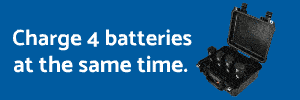- Joined
- Nov 22, 2017
- Messages
- 339
- Reactions
- 44
I am out in the middle of nowhere and only have 2 car cigarette lighter female and car battery power inverter available.
What are the best options (minimum number of batteries, minimum number and type of chargers, and usage strategy) to continuously keep flying the M2P back-to-back (landing for battery and memory card change only, then take off = 5 min between flights)?
In other words, I am looking for the minimum equipment that will provide charged batteries faster than they are being used for flying.
(As a part of this question: in real-life situations, how long it takes for the hub ( DJI Battery Charging Hub for Mavic 2 Pro) to charge one (1) battery in full?)
What are the best options (minimum number of batteries, minimum number and type of chargers, and usage strategy) to continuously keep flying the M2P back-to-back (landing for battery and memory card change only, then take off = 5 min between flights)?
In other words, I am looking for the minimum equipment that will provide charged batteries faster than they are being used for flying.
(As a part of this question: in real-life situations, how long it takes for the hub ( DJI Battery Charging Hub for Mavic 2 Pro) to charge one (1) battery in full?)











